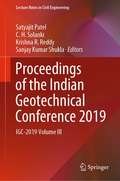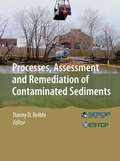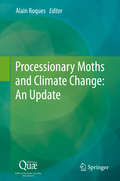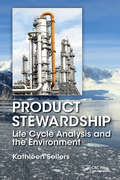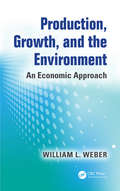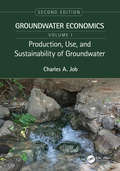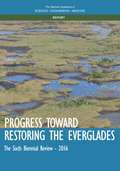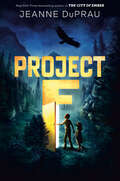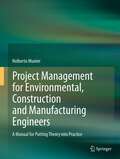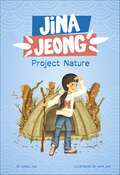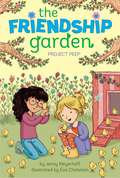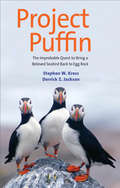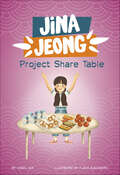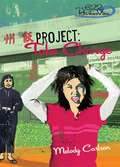- Table View
- List View
Proceedings of the Indian Geotechnical Conference 2019: IGC-2019 Volume III (Lecture Notes in Civil Engineering #136)
by Sanjay Kumar Shukla Krishna R. Reddy C. H. Solanki Satyajit PatelThis book comprises select proceedings of the annual conference of the Indian Geotechnical Society. The conference brings together research and case histories on various aspects of geotechnical and geoenvironmental engineering. The book presents papers on geotechnical applications and case histories, covering topics such as (i) Characterization of Geomaterials and Physical Modelling; (ii) Foundations and Deep Excavations; (iii) Soil Stabilization and Ground Improvement; (iv) Geoenvironmental Engineering and Waste Material Utilization; (v) Soil Dynamics and Earthquake Geotechnical Engineering; (vi) Earth Retaining Structures, Dams and Embankments; (vii) Slope Stability and Landslides; (viii) Transportation Geotechnics; (ix) Geosynthetics Applications; (x) Computational, Analytical and Numerical Modelling; (xi) Rock Engineering, Tunnelling and Underground Constructions; (xii) Forensic Geotechnical Engineering and Case Studies; and (xiii) Others Topics: Behaviour of Unsaturated Soils, Offshore and Marine Geotechnics, Remote Sensing and GIS, Field Investigations, Instrumentation and Monitoring, Retrofitting of Geotechnical Structures, Reliability in Geotechnical Engineering, Geotechnical Education, Codes and Standards, and other relevant topics. The contents of this book are of interest to researchers and practicing engineers alike.
Processes, Assessment and Remediation of Contaminated Sediments
by Danny D. ReibleThe purpose of this book is to help engineers and scientists better understand contaminated sediment sites and identify and design remedial approaches that are more efficient and effective. Contaminated sediment management is a difficult and costly exercise that is rarely addressed with easily identified and implemented remedies. It is hoped that this book can help identify and implement management approaches that provide an optimal, if not entirely satisfactory, solution to sediment contaminant problems.
Processionary Moths and Climate Change: An Update
by Alain RoquesBecause of its peculiar biology, its negative impacts on forestry, and its urticating larvae affecting human and animal health, pine processionary moth has largely been studied in many European countries during the last century. However, knowledge remained scattered and no synthesis has ever been published. Since the IPCC retained the moth as one of the two insect indicators of climate change because of its expansion with warming up, filling this gap became increasingly important. Led by INRA, this book associates 101 authors from 22 countries of Europe, Minor Asia and North Africa, combining all the concerned research fields (entomology, ecology, genetics, mathematical modelling, medical and veterinary science, pest management) in a multidisciplinary approach to understand and model the processes underlying past, present and future moth expansion and to propose adapted management methods. Besides, the major biological patterns of the related processionary species are also detailed.
Producing Liquid Fuels from Coal
by David S. Ortiz Frank Camm James T. BartisLarge U.S. coal reserves and viable technology make promising a domesticindustry producing liquid fuels from coal. Weighing benefits, costs, andenvironmental issues, a productive and robust U.S. strategy is to promote alimited amount of early commercial experience in coal-to-liquids productionand to prepare the foundation for managing associated greenhouse-gasemissions, both in a way that reduces uncertainties and builds futurecapabilities.
Product Stewardship: Life Cycle Analysis and the Environment
by Kathleen SellersConsider the Consequences of Bringing a Chemical to MarketProduct Stewardship: Life Cycle Analysis and the Environment explores the regulatory and scientific aspects of the life-cycle consequences of bringing a chemical to market. Using case studies to bring critical points to life, this multidisciplinary text explores the factors that influence ou
Production, Growth, and the Environment: An Economic Approach
by William L. WeberWritten in a way that facilitates understanding of complex concepts, laws, and policy, Production, Growth, and the Environment: An Economic Approach explores how economic growth usually makes people better off, but also asks at what environmental cost? These costs are not often realized until after the fact, when their remediation is more expensive
Production, Use, and Sustainability of Groundwater: Groundwater Economics, Volume 1
by Charles A. JobGroundwater is becoming increasingly scarce while the demand for water continues to grow at a global scale. Understanding groundwater resources and their sustainable management is imperative for the future of groundwater use, conservation and protection. This revised and updated two-volume set, focused on sustainability, covers the economic values of groundwater production and use, including micro- and macroeconomic factors, groundwater markets, economic evaluation tools, climate change, transboundary issues and policy evaluation. It explores numerous applications and describes ways to evaluate the economics of groundwater use in the context of the larger ecosystem and the natural capital it provides. FEATURES OF THIS VOLUME Includes an important new chapter on groundwater sustainability management Addresses new examples of groundwater use that are applicable at both the local and international levels Provides the foundation for policy, program and project analysis for all major uses of groundwater Updates groundwater use data along with explanations of major production costs and use benefits Gives a new perspective on users’ competition for the subsurface environment Production, Use, and Sustainability of Groundwater, Second Edition, the first volume of the two-volume set Groundwater Economics, is a must-have for any professional or student who needs to understand, evaluate and manage water resources from a range of production and use perspectives affecting groundwater resource sustainability.
Professor Goose Debunks Goldilocks and the Three Bears (Professor Goose Debunks Fairy Tales #1)
by Paulette BourgeoisThe first in a new series by the author of Franklin the Turtle! Join Professor Goose in this STEM-filled picture book as she fact-checks classic fairy tales and shares the science behind these flawed stories.Mother Goose's fairy tales are NOT based in science, and her great niece Professor Goose thinks it's time to share the truth. Join Professor Goose as she — literally — travels through the pages of Goldilocks and the Three Bears, fact-checking, exposing the flaws and explaining the science. Bears don't live in cottages — they prefer dens! The smallest bowl of porridge wouldn't be "just right" — it would have been the coldest! Professor Goose is delighted to see Baby Bear use the scientific method and Goldilocks's fight or flight response. And maybe Goldilocks should have used a GPS so she wouldn't have gotten lost in the first place?Jammed with jokes and wonderfully silly illustrations, this book entertains while it introduces basic scientific laws and rules to young readers. At the back of the book, readers will find Professor Goose's instructions on how to engineer their own chair for a (teddy) bear!
Professor Goose Debunks The Three Little Pigs (Professor Goose Debunks Fairy Tales #2)
by Paulette BourgeoisThe second in a fractured fairy tale series by the author of Franklin the Turtle! Join Professor Goose in this STEM-filled picture book as she fact-checks classic fairy tales and shares the science behind these flawed stories.Mother Goose's fairy tales are NOT based in science, and her great niece Professor Goose thinks it's time to share the truth. Join Professor Goose as she — literally — travels through the pages of The Three Little Pigs, fact-checking, exposing the flaws and explaining the science. Did you know that pigs run in a zigzag pattern? And that there's no way a wolf's breath would be strong enough to blow down anything, even if he has his whole pack with him? And that hay bales are strong enough to resist most up, down and sideways forces? Sounds like the perfect material for building a house! . . . Or, not. But not to worry — Professor Goose is armed with helpful hints on how to make a structure strong enough to withstand hurricane forces! Jammed with jokes and hilarious illustrations, this book entertains while it introduces basic scientific laws and rules to young readers. At the back of the book, readers will find Professor Goose's new, carefully researched fairy tale ending as well as her favorite facts about coding!
Professor Goose Debunks The Three Little Pigs (Professor Goose Debunks Fairy Tales)
by Paulette BourgeoisThe second in a fractured fairy tale series by the author of Franklin the Turtle! Join Professor Goose in this STEM-filled picture book as she fact-checks classic fairy tales and shares the science behind these flawed stories.Mother Goose's fairy tales are NOT based in science, and her great niece Professor Goose thinks it's time to share the truth. Join Professor Goose as she — literally — travels through the pages of The Three Little Pigs, fact-checking, exposing the flaws and explaining the science. Did you know that pigs run in a zigzag pattern? And that there's no way a wolf's breath would be strong enough to blow down anything, even if he has his whole pack with him? And that hay bales are strong enough to resist most up, down and sideways forces? Sounds like the perfect material for building a house! . . . Or, not. But not to worry — Professor Goose is armed with helpful hints on how to make a structure strong enough to withstand hurricane forces! Jammed with jokes and hilarious illustrations, this book entertains while it introduces basic scientific laws and rules to young readers. At the back of the book, readers will find Professor Goose's new, carefully researched fairy tale ending as well as her favorite facts about coding!
Programming for Parks, Recreation, and Leisure Services: A Servant Leadership Approach (3rd Edition)
by Donald G. Degraaf Debra J. Jordan Kathy H. DegraafThis book is about the art and science of the complete programming process. The authors strive to go beyond merely presenting the knowledge and skills needed to provide quality programs; they suggest the integration of values into this process. They do this from a servant leadership perspective.
Progress Toward Restoring the Everglades: The Sixth Biennial Review - 2016
by Engineering Medicine National Academies of SciencesThe Everglades ecosystem is vast, stretching more than 200 miles from Orlando to Florida Bay, and Everglades National Park is but a part located at the southern end. During the 19th and 20th centuries, the historical Everglades has been reduced to half of its original size, and what remains is not the pristine ecosystem many image it to be, but one that has been highly engineered and otherwise heavily influenced, and is intensely managed by humans. Rather than slowly flowing southward in a broad river of grass, water moves through a maze of canals, levees, pump stations, and hydraulic control structures, and a substantial fraction is diverted from the natural system to meet water supply and flood control needs. The water that remains is polluted by phosphorus and other contaminants originating from agriculture and other human activities. Many components of the natural system are highly degraded and continue to degrade. Progress Toward Restoring the Everglades is the sixth biennial review of progress made in meeting the goals of the Comprehensive Everglades Restoration Plan (CERP). This complex, multibillion-dollar project to protect and restore the remaining Everglades has a 30-40 year timeline. This report assesses progress made in the various separate project components and discusses specific scientific and engineering issues that may impact further progress. According to Progress Toward Restoring the Everglades, a dedicated source of funding could provide ongoing long-term system-wide monitoring and assessment that is critical to meeting restoration objectives. This report examines the implications of knowledge gained and changes in widely accepted scientific understanding regarding pre-drainage hydrology, climate change, and the feasibility of water storage since the CERP was developed.
Progressive Development
by Arie S. IssarThe book is based on the results of the investigations of the authors in the semi-arid and arid regions (ASAR) of the globe. These investigations brought to the conclusion that the warming climate will cause the drying up of the water resources in these regions. In this case the principles of Sustainable Development will not be able to avert forthcoming catastrophes. These conclusions brought to the compilation of the policy of "Progressive Development", emphasising investment in the development of new water resources and changing the natural environments while advancing the local populations on the dimension of knowledge by education.
Project Earth (Jina Jeong)
by Carol KimJina is learning about climate change for a class project. What she discovers leads her to making plans to reduce energy use around her house. Her plans run into a few snags, and she becomes frustrated about whether she’s doing enough. With the help of her understanding parents and teacher along with a new friend, Jina finds out even small changes can lead to positive outcomes.
Project F
by Jeanne DuPrauFrom the bestselling author of The City of Ember comes a post-apocalyptic story set hundreds of years in the future, where life is simple and modern conveniences are a thing of the past until a boy enchanted by technology is forced to choose between doing the right thing for his community and pursuing his dreams of adventure.WELCOME TO THE FUTURE.There are no cars, planes, television, or smart phones. Climate change wreaked havoc on Earth hundreds of years ago, and now people live a simpler life. Then thirteen-year-old Keith uncovers a secret. It&’s a mysterious mission known only as Project F. It&’s advanced, it&’s scientific, and it&’s going to change the world. It&’s exactly the kind of adventure Keith has always longed to be a part of.And what is adventure without a little danger, right? But how much danger is Keith willing to risk? For himself? For his family? For his community? For the entire world…?Jeanne DuPrau's The City of Ember was an instant hit when it arrived on bookshelves. It has become a modern classic beloved by readers selling hundreds of thousands of copies a year! In her latest novel, she explores timely questions about the Earth and our use of its resources. A bold novel, Project F asks how much you are willing to risk to save the future.
Project Go Green (Alyssa Milano's Hope)
by Debbie Rigaud Alyssa MilanoHope Roberts saves the planet!In the fourth book in Alyssa Milano's funny and relatable middle-grade series, Hope Roberts is determined to save the worldliterally. Hope has already gotten her school to add more recycling bins and coordinate a carpooling program. But it's not enough. Hope wants to do more to protect the environment before it's too late. But will Hope's plans to help the planet backfire?Hope's relatability, kindness, empathy, and can-do attitude will inspire a generation of do-gooders. This series is a response to the very palpable feeling that not only can young people save the worldthey will!This story will include Hope's tips about recycling and protecting the environment in the back of the book!
Project Management for Environmental, Construction and Manufacturing Engineers: A Manual for Putting Theory into Practice
by Nolberto MunierAs a companion to books on project-management theory, this book illustrates, in a down-to-earth, comprehensive style, how to put that theory into practice. In addition to the many examples that illustrate procedures, the book includes over 25 case studies, each one addressing a specific theme. Key topics, such as project selection, negotiations, planning and scheduling, cost and budgeting, project control, human resources, environmental impacts, risk management, and financial evaluation, are discussed, using a step-by-step approach. Beginning at the grassroots level, some cases are solved by hand to illustrate the mechanics of a procedure, while others are solved using advanced computer programs. In this way the reader has a clear idea of the problem, how and when to raise the issue, information needed (and who can provide it), how to solve it by hand, when possible, and also its resolution using the latest informatics tools.
Project Nature (Jina Jeong)
by Carol KimJina and her family like to spend time in nature. When Jina learns that a lot of kids don’t often experience the great outdoors, she comes up with plans to start her very own nature club. But when Jina’s parents put a damper on her plans, Jina has to find another way to make a difference. Can she introduce other kids to the joys of nature?
Project Peep
by Éva Chatelain Jenny MeyerhoffAnna and her community gardening friends spring into action to help raise baby chicks in the third book in the Friendship Garden series.When Anna moved to Chicago, Kaya became her first real friend, so for her birthday Anna is determined to give Kaya the best present ever! The problem is, the thing Kaya wants more than anything is a pet, but her parents have a strict no-pets rule. Then Anna remembers that Mr. Hoffman's third-grade class just hatched baby chicks! Anna decides that rather than sending the chicks back to the farm, she'll convince her teacher to let the Friendship Garden raise them, so Kaya can have a pet of her own. But raising chicks is no easy task. It requires supplies (that cost money) and building things like a coop and a run. How is Anna supposed to get everything ready and keep it a surprise...especially when Anna and Kaya usually hang out every day? Kaya begins to suspect "fowl play" and assumes Anna is ditching her as a friend! Anna feels terrible and what was supposed to be the best birthday present ever quickly turns into the worst one. Will Anna be able to come up with a way to win her best friend back before the chicks get sent back to the farm for good?
Project Puffin
by Derrick Z. Jackson Stephen W. KressDetails a wildlife scientist's successful efforts to restore puffin colonies in Maine through an experiment in habitat restoration.
Project Share Table (Jina Jeong)
by Carol KimJina Jeong wants to stop wasting food! She can&’t believe how much food gets thrown away at home and at her school. When she finds out how food waste impacts the environment, she wants to take action! Jina makes a plan to stop wasting food at home. With help from her school&’s custodians, Jina and her friends start a Share Table so kids can donate their uneaten food instead of throwing it in the trash.
Project Star: The Universe In Your Hands
by Harold P. Coyle Harvard Observatory StaffFun activities to learn about the universe and astronomy.
Project WILD K-12 Curriculum & Activity Guide
by Council for Environmental EducationProject WILD is an interdisciplinary conservation and environmental education program emphasizing wildlife. The goal of Project WILD is to assist students of any age in developing awareness, knowledge, skills, and commitment to result in informed decisions, responsible behavior, and constructive actions concerning wildlife and the environment.
Project: Take Charge (Girls of 622 Harbor View, Book 4)
by Melody CarlsonWhen vandals trash McPhearson Park, Amy leads the way as she, Morgan, Carlie, Emily, and Chelsea, the newest club member, make it their project to save the spot from being turned into a parking lot and restore it to a place of beauty and fun.
Projective Simulation in Action: Quantum-Mechanical Perspectives on the Problem of Agency (Synthese Library #507)
by Thomas Müller Hans J. BriegelThis open access monograph presents an in-depth study of the problem of how agency fits into the physical world. In particular, the authors focus on agency as a precondition of free will. They present a detailed and physically well motivated formal model to anchor their philosophical discussion. Coverage brings together perspectives from physics, computer science, and different branches of philosophy. The book describes the agency model of Projective Simulation, its physical realisability and its quantum extensions. It situates this model within the discussion of agency in philosophy and in Artificial Intelligence. In addition, the authors highlight the role of agency in Quantum Mechanics itself, recently stressed by the Bayesian-inspired interpretation of Quantum Mechanics, QBism. They provide a comprehensive exposition of Quantum Mechanics and a reflection on the embodied nature of agents. (Quantum) indeterminism turns out to be a key resource for Projective Simulation, and for agency in general. This establishes a novel connection between agency and phenomenology. Overall, the book provides a coherent picture of agents as persisting physical entities endowed with active capacities. Such an explanation does not necessarily settle the question of the actual empirical basis of our human agency. It does, however, show that a coherent notion of agency is possible within a modern scientific world-view.
